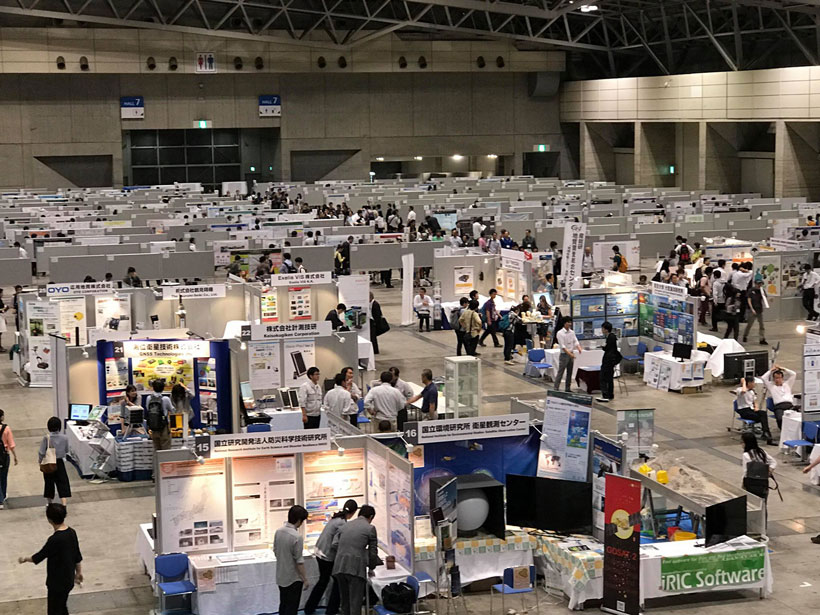The Japan Geosciences Union–American Geophysical Union (JpGU-AGU) Joint Meeting in Chiba, Japan, has come to a close, and we’ve said goodbye to a wonderful team of Japanese co-organizers. This meeting, the first of its kind between these organizations, arose from an idea conceived in 2014—an idea to advance Earth and space science by expanding the JpGU annual meeting and increasing participation from scientists outside of the region.
The resulting collaborative event, which drew 8450 attendees, was a resounding success. As I attended sessions and walked through the poster hall, I was reminded again and again of our borderless scientific world.
Sharing Visions and Ideas
JpGU and AGU worked to ensure that we developed the scientific program and accompanying events together and made them reflective of the missions and visions of both of our organizations.
Although a joint meeting might seem like an easy proposal, planning a complex scientific event that reflects both organizations is a challenging task. Every society has a culture, traditions, and norms that are its own. Beginning in 2015, under the guidance of a joint agreement, JpGU and AGU worked to ensure that we developed the scientific program and accompanying events together and made them reflective of the missions and visions of both of our organizations. All planning was collaborative; we began by discussing our vision and sharing ideas rather than by insisting on planning “the AGU way” or “the JpGU way.” Each organization shared best practices, and each organization tried new things.
With a collaborative planning process underway, the scientific program committee, led by the meeting’s director Hisayoshi Yurimoto of Hokkaido University and committee cochairs Huixin Liu of Kyushu University and Tetsuo Irifune of Ehime University, began to discuss how to create a program where there was something for everyone. Because the meeting traditionally had been held with mostly Japanese presentations, the committee recognized that there was a barrier to participation from non-Japanese-speaking scientists. Thus, JpGU used its 2016 annual meeting to encourage submission of more English language sessions and abstracts.
Ultimately, the joint meeting offered Japanese sessions, English sessions, and a blended session type where the presenter shared slides in English but could present in Japanese. This array of session types resulted in both more sessions for non-Japanese speakers and more positive experiences for Japanese-speaking presenters uncomfortable with giving their entire talks in English.
Two Societies, Two Keynotes
As the meeting moved through the week, our societies blended many traditions.
To reflect the truly joint nature of the meeting, JpGU and AGU selected two keynote speakers, Lucy Jones, formerly with the U.S. Geological Survey and now at the California Institute of Technology in Pasadena, and Takaaki Kajita of the University of Tokyo. Jones, known as the “earthquake lady,” spoke about randomness in seismic events and the difficulty of predicting earthquakes, framed in the context of human behavior and understanding. Kajita discussed how our understanding of cosmic rays has changed since their discovery more than 100 years ago and shared where this area of science is headed. These thought leaders gave talks that were vastly different scientifically, yet both spoke of scientific realms in which predictions are difficult to make and researchers study evidence and risks that are largely imperceptible to human senses.
As the meeting moved through the week, our societies blended many traditions. AGU helped organize student pop-up talks, renamed Oshaberi Bar Pop-Up Talks, which were well received by joint meeting attendees. An elegant award ceremony complete with Japanese drumming and a sake bar made for a wonderful midmeeting event. In addition, numerous hot topic sessions and author workshops rounded out a full program of scientific presentations.
Of course, there was also beer! It’s a tradition at both AGU and JpGU.

Standing Stronger Together
Having completed the meeting and wished our Earth and space scientists safe travels home, we look forward to informing our work at AGU with what we learned on site in Japan and throughout the planning process: AGU is a global society in our borderless geoscience world.
There may be those who ask why AGU didn’t just host its own meeting and partnered with another established society. As I reflect on the week of the joint meeting, it’s clear to me that we are stronger when we stand together. JpGU and AGU created something unique that honored the mission and vision of both organizations. More than a sum of its parts, it was a collaborative effort that neither society could have achieved completely on its own—much like the scientific enterprise in which our members around the world endeavor every day.
—Lauren Parr (email: [email protected]), Vice President, Meetings, AGU
Correction, 12 June 2017: This article has been updated with the most recent attendance figure.
Citation:
Parr, L. (2017), Japan-U.S. joint meeting: Geoscience for a borderless world, Eos, 98, https://doi.org/10.1029/2017EO075663. Published on 12 June 2017.
Text © 2017. The authors. CC BY-NC-ND 3.0
Except where otherwise noted, images are subject to copyright. Any reuse without express permission from the copyright owner is prohibited.

